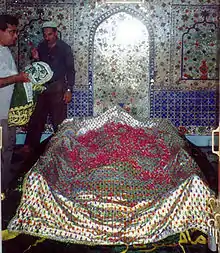Bari Imam
Syed Abdul Latif Kazmi, often referred to as Barī Imām or Barī Sarkār (1617 – 1705), was a 17th-century Sufi ascetic from Punjab. He is venerated as the patron saint of Islamabad, Pakistan. Born in Karsal, Chakwal District to a Sayyid family, he was one of the most prominent Sufi of the Sunni school of thought. Today, he is one of the most popular and widely venerated saints of Punjab.[2][3][1]
Barī Imām بری امام | |
|---|---|
 A popular local depiction of Barī Imām | |
| Mystic | |
| Born | 1617 CE (1026 AH)[1] Choli Karsal, Punjab, Mughal Empire (now in Punjab, Pakistan) |
| Died | 1705 CE (1114 AH)[1] Noorpur, Punjab, Mughal Empire (now in Islamabad, Pakistan) |
| Venerated in | By all those Muslims who venerate saints, especially in the Indian Subcontinent |
| Feast | 24 May (urs) |
| Patronage | Pothohar Plateau |
Tradition or genre | kazmi |
Syed Abdul Latif Kazmi | |
|---|---|
| Title | Imam Ul Fuqra, Shehnsha E Behro Bar, Hazrat, Sayyid, Imam, Pak Bari |
| Personal | |
| Religion | Sunni Islam |
| Region | Punjab |
| Main interest(s) | Sufism |

The life of Bari Imam is known essentially through oral tradition and hagiographical booklets and celebrated in Qawwali songs of Indian and Pakistani Sufism.[2]

Biography
Bari Imam was eight years old when his family migrated from Karsal in Chakwal District to what is now Aabpara, Islamabad in Pakistan. Additionally, Syed Kasran in the Tehsil of Gujjar Khan is considered to be his Birthplace.[4] His father, Syed Mehmood Shah, was a farmer. So he helped his father with farming and with his herd of animals until he was 12 years old. Then Bari Imam was sent to Ghorghushti in Campbellpur (now known as Attock, Punjab, Pakistan) where he stayed for two years to learn fiqh, hadith, logic, and other disciplines related to Islam, because at that time Ghorghushti was a renowned seat of Islamic learning.[5]
According to some sources, he later married and had one daughter, though both his wife and daughter are said to have died prematurely.[2] After their passing, Bari Imam began wandering the forests of the Hazara district in Khyber Pakhtunkhwa, where he spent twenty-four years as an ascetic.[2]
Shah Abdul Latif also went to Central Asian states of that period and to the Islamic holy cities of Mecca and Madinah to learn about Islam and perform hajj.[1][3]
After his return to the Indian subcontinent, he then decided to settle in the Noorpur Shahan area (now Noorpur Shahan in Islamabad). At that time, this area was known to be a dangerous place (locally known as Chorpur (place of thieves) due to its reputation as full of bandits and killers who used to attack and rob trade caravans passing through this area headed towards Central Asian countries. Over time, he succeeded in teaching these people about love, peace and harmony. Later Shah Abdul Latif came to be known as "Bari Imam".[1][6]
Because Bari Imam Sarkar did not transmit any of his doctrines to writing; as such, it may be rightly presumed that he bequeathed all of his teachings orally.[7]
Bari Imam was renowned in his own life for being an ascetic who subjected himself to great self-humiliation in the public sphere, "living among the pariahs and consciously exposing himself to the disdain of the people."[2][8]
A celebrated miracle worker, Bari Imam is also described in regional lore as one through whom God performed many marvels to convince the local people of the truth of Islam; thus, some of the most popular miracles ascribed to him are his having caused water to gush forth from rocks and his having brought back to life the dead water buffaloes of a peasant who had earlier provided the saint with milk during his ten years of spiritual seclusion.[2]
Shrine
.jpg.webp)
A silver-mirrored shrine of Bari Imam is located in Noorpur Shahan in Islamabad. It was originally built by the Mughal emperor Aurangzeb, who revered Bari Sarkar, in the 17th century.[1] It has since been renovated many times, and is now maintained by the Government of Pakistan. Until the 1960s, the shrine was famous for its urs celebration, when the death anniversary of the saint was commemorated and which was attended by hundreds of thousands of people each year (in one particularly populous year, the attendance is said to have been 1.2 million people).[2][3]
On 27 May 2005, a suicide attack took place at the shrine of Imam Bari in which 20 people died and almost 70 were injured.[9][1]
References
- Muhammad Umar and Suhail Yusuf (10 July 2014). "Syed Shah Abdul Latif: 'Khushki kay Imam'". Dawn (newspaper). Retrieved 5 January 2021.
- Chaudhary, M. Azam. Imām "Barrī Imām (search results)". In Fleet, Kate; Krämer, Gudrun; Matringe, Denis; Nawas, John; Rowson, Everett (eds.). Encyclopaedia of Islam (3rd ed.). Brill Online. ISSN 1873-9830.
{{cite encyclopedia}}: Check|url=value (help) - (Associated Press of Pakistan) Security plan chalked out for Bari Imam Urs The Nation (newspaper), Published 20 May 2015, Retrieved 5 January 2021
- Punjab District Gazetteers: Rawalpindi District with Maps 1907. The “Civil and Military Gazette” Press, Lahore. 1909.
- "Urs of Bari Imam to start from 22nd". The Nation (newspaper). 10 April 2007. Archived from the original on 6 February 2008. Retrieved 6 January 2021.
- (Mohammad Yousaf Khokhar) Shah Abdul Latif, Nurpur Shahan and Islamabad Kuwait News Agency (KUNA), Published 28 July 2002, Retrieved 5 January 2021
- Ghulām Shabbīr Hāshmī, Ṭulba-yi Shāh Laṭīf, Islamabad, 2010
- Jürgen Wasim Frembgen, Journey to God. Sufis and dervishes in Islam, trans. from the German by Jane Ripken, Karachi and Oxford: Oxford University Press, 2008, pp. 160-161
- "Two involved in Bari Imam suicide attack arrested". Dawn (newspaper). 14 August 2011. Retrieved 5 January 2021.